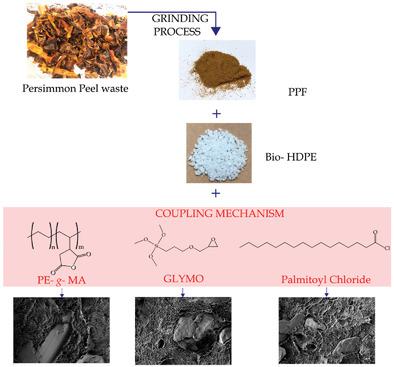当前位置:
X-MOL 学术
›
Macromol. Mater. Eng.
›
论文详情
Our official English website, www.x-mol.net, welcomes your
feedback! (Note: you will need to create a separate account there.)
Manufacturing and Characterization of High-Density Polyethylene Composites with Active Fillers from Persimmon Peel Flour with Improved Antioxidant Activity and Hydrophobicity
Macromolecular Materials and Engineering ( IF 4.2 ) Pub Date : 2021-08-25 , DOI: 10.1002/mame.202100430 Sandra Rojas‐Lema 1, 2 , Diego Lascano 1, 2 , Juan Ivorra‐Martinez 1 , Jaume Gomez‐Caturla 1 , Rafael Balart 1 , Daniel Garcia‐Garcia 1
Macromolecular Materials and Engineering ( IF 4.2 ) Pub Date : 2021-08-25 , DOI: 10.1002/mame.202100430 Sandra Rojas‐Lema 1, 2 , Diego Lascano 1, 2 , Juan Ivorra‐Martinez 1 , Jaume Gomez‐Caturla 1 , Rafael Balart 1 , Daniel Garcia‐Garcia 1
Affiliation

|
The potential of persimmon peel waste (PPF) as renewable active filler in biobased polyethylene composites, with improved antioxidant properties and resistance to water uptake is shown. To improve the interaction between the hydrophilic biofiller and the highly hydrophobic matrix, several compatibilization approaches are assessed. The first approach consists of using a polyethylene grafted copolymer with maleic anhydride (PE-g-MA). The second approach consists of modifying the PPF surface with two treatments before compounding with Bio-HDPE. The first consists on conventional silanization with (3-glycidyloxypropyl)trimethoxysilane, while the second consists on esterification with palmitoyl chloride. The results show an improvement of the matrix/biofiller interaction, as observed by field emission scanning electron microscopy (FESEM), leading to an increase in Young's modulus of 10% in composites compatibilized with PE-g-MA, and silanized PPF compared to composites without compatibilizer and no surface treatment on PPF. Interestingly, treatment with palmitoyl chloride leads to an increase in the hydrophobic behavior of composites keeping the water contact angle virtually constant at 128°. This effect is also reflected in a clear decrease in water absorption capacity of only 0.3 wt% over 9 weeks. Finally, PPF increases stabilization against oxidation, improving the oxidation induction time from 4.8 min (Bio-HDPE) to 82.5 min for composites with silanized PPF.
中文翻译:

具有改进的抗氧化活性和疏水性的柿子皮粉活性填料高密度聚乙烯复合材料的制造和表征
柿子皮废料 (PPF) 在生物基聚乙烯复合材料中作为可再生活性填料的潜力,具有改善的抗氧化性能和抗吸水能力。为了改善亲水性生物填料和高度疏水性基质之间的相互作用,评估了几种增容方法。第一种方法包括使用带有马来酸酐的聚乙烯接枝共聚物 (PE -g-嘛)。第二种方法包括在与 Bio-HDPE 复合之前用两次处理对 PPF 表面进行改性。第一种方法是用(3-缩水甘油氧基丙基)三甲氧基硅烷进行常规硅烷化,而第二种方法是用棕榈酰氯进行酯化。结果表明,通过场发射扫描电子显微镜 (FESEM) 观察到的基质/生物填料相互作用的改善,导致与 PE -g-相容的复合材料的杨氏模量增加 10%MA 和硅烷化 PPF 与不含增容剂且未对 PPF 进行表面处理的复合材料相比。有趣的是,用棕榈酰氯处理会增加复合材料的疏水性,使水接触角几乎保持在 128°。这种效果也反映在吸水能力在 9 周内仅下降 0.3 wt% 的明显下降。最后,PPF 提高了抗氧化稳定性,将硅烷化 PPF 复合材料的氧化诱导时间从 4.8 分钟(Bio-HDPE)提高到 82.5 分钟。
更新日期:2021-08-25
中文翻译:

具有改进的抗氧化活性和疏水性的柿子皮粉活性填料高密度聚乙烯复合材料的制造和表征
柿子皮废料 (PPF) 在生物基聚乙烯复合材料中作为可再生活性填料的潜力,具有改善的抗氧化性能和抗吸水能力。为了改善亲水性生物填料和高度疏水性基质之间的相互作用,评估了几种增容方法。第一种方法包括使用带有马来酸酐的聚乙烯接枝共聚物 (PE -g-嘛)。第二种方法包括在与 Bio-HDPE 复合之前用两次处理对 PPF 表面进行改性。第一种方法是用(3-缩水甘油氧基丙基)三甲氧基硅烷进行常规硅烷化,而第二种方法是用棕榈酰氯进行酯化。结果表明,通过场发射扫描电子显微镜 (FESEM) 观察到的基质/生物填料相互作用的改善,导致与 PE -g-相容的复合材料的杨氏模量增加 10%MA 和硅烷化 PPF 与不含增容剂且未对 PPF 进行表面处理的复合材料相比。有趣的是,用棕榈酰氯处理会增加复合材料的疏水性,使水接触角几乎保持在 128°。这种效果也反映在吸水能力在 9 周内仅下降 0.3 wt% 的明显下降。最后,PPF 提高了抗氧化稳定性,将硅烷化 PPF 复合材料的氧化诱导时间从 4.8 分钟(Bio-HDPE)提高到 82.5 分钟。











































 京公网安备 11010802027423号
京公网安备 11010802027423号